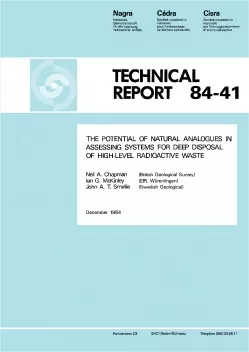
Technical Report NTB 84-41
The potential of natural analogues in assessing systems for deep disposal of high-level radioactive waste
Many of the processes which will lead to the breakdown of engineered barriers and the mobilisation of radionuclides in a deep waste repository have analogies in natural geological systems. These "natural analogues" are seen as a particularly important means of validating predictive models, under the broad heading of radionuclide migration, which are used in long-term safety analyses. Their principal value is the opportunity they provide to examine processes occurring over geological timescales, hence allowing more confident extrapolation of short timescales experimental data.
This report begins by reviewing the processes leading to breakdown of containment in a high-level radioactive waste repository in crystalline bedrock and the subsequent migration mechanisms for radionuclides back to the biosphere. Nine specific processes are identified as being of the most significance in migration models, based on available sensitivity analyses. These processes are considered separately in detail, reviewing first the mechanisms involved and the most important unknowns then the types of natural analogue which could most usefully provide supporting evidence for the effects of the process. Existing studies are assessed and possibilities considered for additional analogues. Conclusions are drawn, for each process as to the extent to which analogues validate current predictions on scale and effect, longevity of function, etc. Where possible, quantitative evaluations are given, derived from analogue studies.
A summary is provided of the conclusions for each process, and the most important topics for furhter studies are listed. Specific examples of these requisite analogues are given.
The report emphasises throughout the importance of linking analogues to well defined processes, concluding that analogues of complete disposal systems do not exist. While the report is aimed specifically at the Nagra (Switzerland) and KBS (Sweden) concepts for disposal of high-level wastes or spent fuel, the results are seen to be more widely applicable. A considerable amount of the information reviewed and presented could be used in the assessment of disposal of other waste types in other host rocks.
